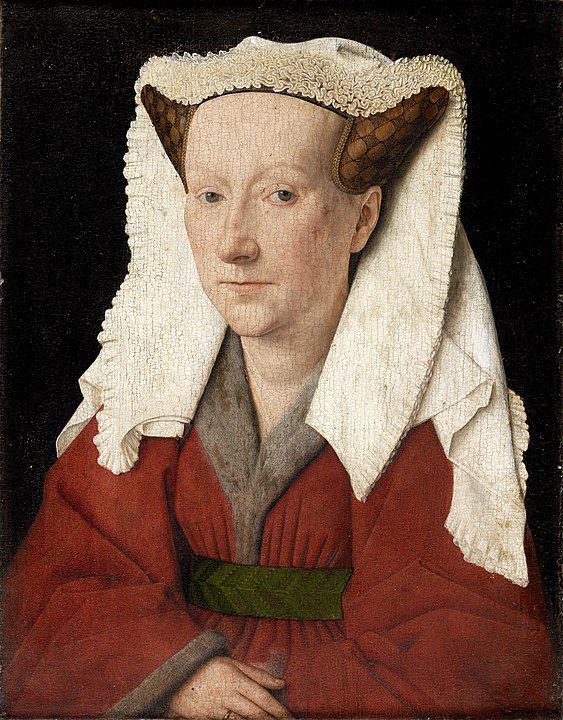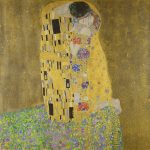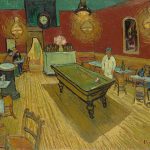
Jan van Eyck and Margaret van Eyck’s love story is one that has captivated the imaginations of art historians and romantics alike for centuries. While many details of their personal lives have been lost to time, what remains paints a picture of a deeply affectionate and supportive relationship. Their union was likely one of mutual respect, admiration, and shared values, fostering an environment in which Jan van Eyck could thrive artistically.
In an era when marriages were often arranged for political or economic reasons, the relationship between Jan and Margaret appears to have been based on genuine affection and love. This in itself was a rare thing in the 15th century. The fact that Jan chose to include Margaret in one of his most significant works suggests that their bond went beyond the ordinary. They were not just husband and wife; they were partners in every sense of the word.
The couple lived in Bruges, a city that was a bustling center of commerce and culture during their time. This environment would have provided them with access to the finest goods, the most interesting people, and the latest ideas. Yet, despite the hustle and bustle of city life, it seems that Jan and Margaret cherished the quiet moments they could spend together, away from the demands of the outside world. Their home likely served as a sanctuary where Jan could retreat and find inspiration in the presence of his beloved wife.
Jan van Eyck’s decision to include a figure resembling Margaret in “The Arnolfini Portrait” might have been a testament to the deep love he felt for her. While the identity of the woman in the painting remains a topic of debate, many art historians believe that Jan used Margaret as a model for this work. If this is true, it suggests that Jan saw Margaret as an ideal of beauty, grace, and dignity—qualities that he wanted to immortalize in his art.
The Supportive Bond Between Jan and Margaret
Marriage in the Renaissance period was often centered around practical concerns. However, in the case of Jan and Margaret, their relationship appears to have transcended the typical roles of husband and wife. They seem to have shared a bond that was not only based on love but also on a deep understanding of each other’s needs and ambitions.
Margaret’s role in Jan’s life, though not well documented, was likely one of quiet but unwavering support. She may have managed the household and taken care of their children, allowing Jan the freedom to focus on his art. This kind of support would have been invaluable to Jan, who was known for his meticulous attention to detail and the time-consuming nature of his work. Margaret’s contributions to their household, though largely invisible to history, were undoubtedly crucial to Jan’s success as an artist.
The love between Jan and Margaret was likely strengthened by the shared joys and challenges of raising a family. They had several children together, and it is easy to imagine the pride and happiness they felt in watching their children grow. The van Eyck home would have been filled with the sounds of laughter, the chatter of children, and the quiet moments of domestic life that bind a family together.
Their marriage would have also faced its share of difficulties, as all marriages do. The pressures of Jan’s career, the challenges of raising children, and the demands of daily life would have tested their bond. However, it seems that Jan and Margaret weathered these storms together, emerging stronger and more united. The strength of their relationship is perhaps best seen in the longevity of Jan’s career and the enduring impact of his work. Behind every great artist, there is often a partner who provides the support and stability needed for creative genius to flourish, and for Jan van Eyck, that partner was Margaret.
Love Immortalized in Art
Art has long been a way for people to express their deepest emotions, and for Jan van Eyck, his love for Margaret may have been one of his greatest inspirations. The theory that Margaret was the model for the woman in “The Arnolfini Portrait” adds a deeply personal dimension to this work. If true, the painting can be seen not just as a portrait of a wealthy couple, but as a tribute to the love Jan felt for his wife.
The inclusion of Margaret in such a significant work suggests that Jan wanted to honor her in a way that would be remembered for generations. By immortalizing her in his art, Jan ensured that Margaret’s presence would be felt long after their time. The painting itself, with its intricate details and symbolism, reflects the depth of emotion that Jan poured into his work. Every brushstroke, every carefully rendered detail, is a testament to the love and dedication that fueled his art.
But even beyond this particular painting, the influence of Margaret can be felt in the warmth and humanity that characterizes Jan van Eyck’s portraits. His ability to capture the essence of his subjects—their inner life, their dignity, their individuality—may have been shaped by the love and respect he felt for Margaret. It is possible that his deep connection with her helped him to see beyond the surface, to capture the soul of the people he painted.
The Legacy of Their Love
The love story of Jan and Margaret van Eyck is not just a historical footnote; it is a reminder of the power of love to inspire and sustain great art. Their relationship, though largely hidden from the public eye, played a crucial role in the creation of some of the most important works of the Renaissance. Without Margaret’s support, it is possible that Jan would not have achieved the same level of success. Her influence, though subtle, was profound.
The legacy of their love can be seen not just in Jan’s paintings, but in the way he approached his work. His meticulous attention to detail, his innovative use of oil paints, and his ability to capture the humanity of his subjects all reflect a deep commitment to his craft—a commitment that was likely nurtured and supported by Margaret. Their partnership was one of mutual respect and admiration, and it is this partnership that helped to shape the course of art history.
Moreover, their love story serves as an inspiration for us today. It is a reminder that behind every great achievement, there is often a network of support and love that makes it possible. Jan van Eyck’s art continues to inspire and move people around the world, and behind that art is the quiet, steady presence of Margaret, his wife and muse. Their love, though not always visible, is woven into the fabric of Jan’s work, and it is this love that continues to resonate with us centuries later.
The Human Side of Jan van Eyck
The image of Jan van Eyck as a master artist is well established, but it is important to remember that he was also a man—a man who loved, who struggled, and who sought to leave a lasting legacy. His relationship with Margaret humanizes him, reminding us that even the greatest artists are shaped by the people they love.
Margaret’s influence on Jan likely extended beyond the domestic sphere. It is possible that her insights, her perspective, and her presence helped to shape Jan’s understanding of the world. In turn, this understanding would have influenced the way he approached his art. The emotional depth and complexity of his portraits suggest a sensitivity to the human experience that may have been enriched by his relationship with Margaret.
The fact that Jan chose to include a figure resembling Margaret in one of his most famous works speaks volumes about their relationship. It suggests that Margaret was not just a background figure in Jan’s life, but a central part of it. Their love was likely a source of inspiration for Jan, helping him to see the world in new ways and to capture that vision on canvas.
In many ways, the story of Jan and Margaret van Eyck is a story of partnership—of two people who, together, created something greater than the sum of their individual parts. Their love, their mutual support, and their shared life helped to shape the course of art history. And in that, their legacy lives on, not just in the paintings that hang in museums, but in the love that inspired them.
Margaret’s Lasting Impact
While Margaret van Eyck did not leave behind any works of art or writings that we know of, her impact on Jan’s work is undeniable. Her presence in his life provided the foundation upon which he built his career, and her influence can be felt in the warmth and humanity that characterizes his art. Without her, it is possible that Jan van Eyck would not have become the artist we know today.
The strength of their relationship is evident in the enduring nature of Jan’s work. His paintings continue to captivate audiences around the world, and the love that he and Margaret shared is part of what makes those paintings so powerful. It is a love that transcends time and space, reaching out across the centuries to touch our hearts today.
In recognizing Margaret’s impact, we also recognize the importance of the often unseen support that allows great art to flourish. Behind every masterpiece, there is a story of love, dedication, and partnership. Jan and Margaret’s story is one of those stories—a story that reminds us of the power of love to inspire, to sustain, and to create.
Their love story is one for the ages, a reminder that even in a world focused on power and wealth, the most important thing is the love and support we give and receive from those closest to us. Jan van Eyck’s art is a testament to that love, and it is through his work that Margaret’s legacy lives on.
Conclusion: Love Immortalized
Jan and Margaret van Eyck’s love story is a reminder of the profound impact that love and partnership can have on creativity and success. Their relationship, while not widely documented, played a crucial role in shaping Jan’s career and, by extension, the course of art history. The love they shared provided the foundation upon which Jan could build his extraordinary body of work.
Jan van Eyck’s paintings continue to be celebrated for their technical mastery and emotional depth. Yet, it is the love story behind these works that adds an extra layer of richness and meaning. Margaret’s quiet support and enduring presence in Jan’s life were integral to his success, and their love is immortalized in the art that continues to inspire us today.
In the end, the story of Jan and Margaret van Eyck is not just a story about art; it is a story about the power of love to create, to sustain, and to leave a lasting legacy. Their partnership is a reminder that behind every great achievement, there is often a foundation of love and support that makes it possible. And it is this love, this partnership, that continues to resonate with us, even centuries later.




